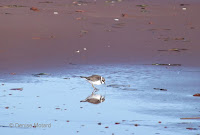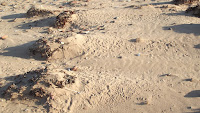SEMIPALMATED PLOVER
SEMIPALMATED PLOVER (Charadrius semipalmatus) – (See images below)
DESCRIPTION: The semipalmated plover is a small wading shore bird with a brown head and back, a dark brown collar with a white neck band in the back, a white face and white under parts. The bill is yellow at the base with a dark point in breeding plumage, otherwise it is dark. The eyes are black. The legs are yellow. The length of this bird is 7 inches (18 cm).
VOICE: https://www.xeno-canto.org/species/Charadrius-semipalmatus
NAME: The English name ‘Plover’ comes from Latin ‘pluvialis’, which means ‘rain’, due to the thought that this species was somehow associated with rain, which is not the case. It is called ‘semipalmated’ because it has partly webbed feet, which allows it to swim short distances. The Latin genus name ‘Charadrius’ is from ancient Greek and refers to a bird found in ravines or river valleys.
HABITAT: Coastal areas, sandy or rocky beaches, mudflats.
DIET: Invertebrates left behind by breaking waves on sand beaches.
NESTING: The nest is located on the ground in an open area. An average of four dark green eggs are laid, which are incubated by both parents. Chicks are soon food independent but protected by their parents.
DISTRIBUTION: The sempalmated plover breeding range covers the northern part of Canada and Alaska, and some small areas in the Canadian Maritimes. It migrates through the rest of Canada and most of the USA, and spends the winter along the coasts of both Americas. It is a rare visitor to Hawaii.
Distribution map: https://en.wikipedia.org/wiki/Semipalmated_plover#/media/File:Charadrius_semipalmatus_map.svg
ON PEI: The semipalmated plover used to breed on Prince Edward Island, but now it only is observed in groups along sea shores during its migration.
CONSERVATION: The semipalmated plover population appears to be increasing, so it is not considered at risk.
NOTES: This species often associates with the semipalmated sandpiper during its migration. Because the nest is on the ground in open areas, the parents use the ‘broken wing’ strategy to lure potential predators away from the nest.
SIMILAR SPECIES: Piping Plover – the Killdeer, although similar, is larger.
REFERENCES: https://www.audubon.org/field-guide/bird/semipalmated-plover
http://animaldiversity.org/accounts/Charadrius_semipalmatus/
https://en.wikipedia.org/wiki/Semipalmated_plover
https://www.allaboutbirds.org/guide/Semipalmated_Plover/id
https://www.mba-aom.ca/jsp/toc.jsp (Maritimes Breeding Bird Atlas)
https://www.borealbirds.org/bird/semipalmated-plover
This video below shows a semipalmated plover hopping on one leg for a while before switching back to running on its two perfectly healthy legs. This was on a very windy day.
DESCRIPTION: The semipalmated plover is a small wading shore bird with a brown head and back, a dark brown collar with a white neck band in the back, a white face and white under parts. The bill is yellow at the base with a dark point in breeding plumage, otherwise it is dark. The eyes are black. The legs are yellow. The length of this bird is 7 inches (18 cm).
VOICE: https://www.xeno-canto.org/species/Charadrius-semipalmatus
NAME: The English name ‘Plover’ comes from Latin ‘pluvialis’, which means ‘rain’, due to the thought that this species was somehow associated with rain, which is not the case. It is called ‘semipalmated’ because it has partly webbed feet, which allows it to swim short distances. The Latin genus name ‘Charadrius’ is from ancient Greek and refers to a bird found in ravines or river valleys.
HABITAT: Coastal areas, sandy or rocky beaches, mudflats.
DIET: Invertebrates left behind by breaking waves on sand beaches.
NESTING: The nest is located on the ground in an open area. An average of four dark green eggs are laid, which are incubated by both parents. Chicks are soon food independent but protected by their parents.
DISTRIBUTION: The sempalmated plover breeding range covers the northern part of Canada and Alaska, and some small areas in the Canadian Maritimes. It migrates through the rest of Canada and most of the USA, and spends the winter along the coasts of both Americas. It is a rare visitor to Hawaii.
Distribution map: https://en.wikipedia.org/wiki/Semipalmated_plover#/media/File:Charadrius_semipalmatus_map.svg
ON PEI: The semipalmated plover used to breed on Prince Edward Island, but now it only is observed in groups along sea shores during its migration.
CONSERVATION: The semipalmated plover population appears to be increasing, so it is not considered at risk.
NOTES: This species often associates with the semipalmated sandpiper during its migration. Because the nest is on the ground in open areas, the parents use the ‘broken wing’ strategy to lure potential predators away from the nest.
SIMILAR SPECIES: Piping Plover – the Killdeer, although similar, is larger.
REFERENCES: https://www.audubon.org/field-guide/bird/semipalmated-plover
http://animaldiversity.org/accounts/Charadrius_semipalmatus/
https://en.wikipedia.org/wiki/Semipalmated_plover
https://www.allaboutbirds.org/guide/Semipalmated_Plover/id
https://www.mba-aom.ca/jsp/toc.jsp (Maritimes Breeding Bird Atlas)
https://www.borealbirds.org/bird/semipalmated-plover
 |
| Semipalmated plover, PEI, Canada |
 |
| Semipalmated plovers, Brackley Beach |
 |
| Semipalmated plover tracks on beach |